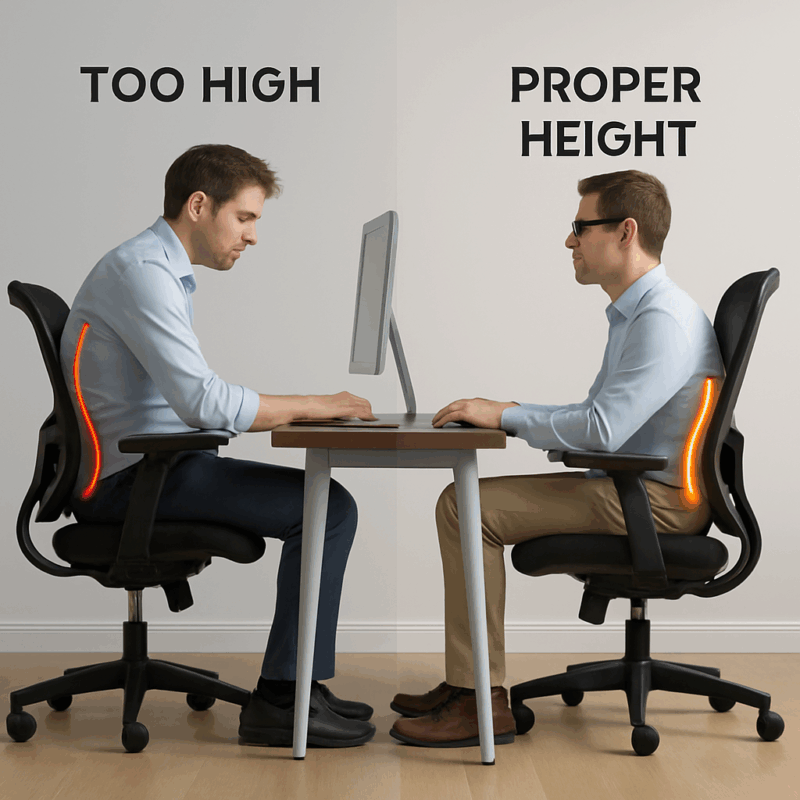The Role of Chair Height in Preventing Lower Back Pain
When it comes to preventing lower back pain in the workplace, most people focus on lumbar support, cushion quality, or the backrest’s shape. Yet one of the simplest and most overlooked factors is chair height. The height of your office chair directly influences posture, spinal alignment, and even the way your muscles engage during prolonged sitting. Get it wrong, and you could be setting yourself up for chronic discomfort. Get it right, and you give your back a fighting chance at staying healthy.

Why Chair Height Matters
Your body functions best when your joints are aligned and muscles are relaxed. Sitting in a chair that is too high or too low forces your body into unnatural positions. If your chair is too high, your feet may dangle or barely touch the floor, putting strain on your thighs and lower back as your body tries to stabilize itself. If your chair is too low, your knees end up higher than your hips, tilting your pelvis backward and rounding your lower spine. Both scenarios create unnecessary tension in the lumbar region and can contribute to pain over time.
The Science of Spinal Alignment
The human spine has a natural S-shaped curve, with the lower back (lumbar region) curving slightly inward. This shape acts as a shock absorber and keeps your body balanced. A poorly adjusted chair height disrupts this alignment, increasing stress on the vertebrae and the surrounding muscles. Studies in ergonomics show that even minor misalignments sustained over hours can lead to inflammation and muscle fatigue, which are precursors to more serious back problems.
Finding the Ideal Height for You
The “perfect” chair height isn’t one-size-fits-all—it depends on your height, desk setup, and the type of work you do. However, there are general ergonomic guidelines. Your chair should be adjusted so your feet rest flat on the floor, knees bent at about 90 to 100 degrees, and thighs parallel to the ground. Your hips should be level with or slightly above your knees to encourage a forward pelvic tilt that supports the natural lumbar curve.
If your desk height forces you to raise your chair beyond this ideal, consider using a footrest. A stable footrest helps maintain proper leg support while preventing your feet from dangling. On the other hand, if lowering your chair causes your knees to rise too high, it may be worth adjusting your desk or keyboard tray instead.
Dynamic Sitting and Micro-Adjustments
Even if your chair height is set perfectly, staying in one static position for hours is not healthy. Your muscles benefit from slight, regular adjustments. Many modern ergonomic chairs offer pneumatic height controls, allowing quick micro-adjustments throughout the day. These small changes shift the load on your muscles and joints, improving circulation and reducing stiffness.
The Ripple Effect on the Whole Body
Chair height affects more than just your lower back. Poor height adjustment can cause you to lean forward excessively, leading to neck strain, shoulder tension, and eye fatigue. Conversely, the right height naturally aligns your torso and head with your screen, reducing the risk of these secondary issues. When the lower body is properly supported, the upper body tends to follow suit, creating a chain reaction of better posture throughout.
Practical Tips for Setting Your Chair Height
Start by standing in front of your chair and adjusting the seat so the top is just below your kneecap. When you sit, check that your feet are flat, thighs parallel to the ground, and your elbows form a roughly 90-degree angle when your hands are on your keyboard. If you share your workspace with others, make it a habit to readjust before each session—your back will thank you for it.
Conclusion
Lower back pain is one of the most common complaints among office workers, but it’s not always caused by complex issues. Sometimes, a simple adjustment like setting your chair to the right height can make a world of difference. By paying attention to how your feet, legs, and hips are positioned, you support your spine’s natural curves and reduce unnecessary strain. In the long run, that small adjustment can be the difference between finishing your workday with energy or with an aching back.





